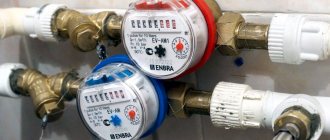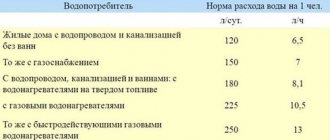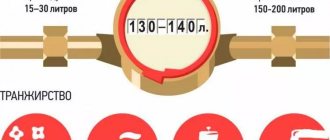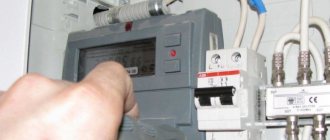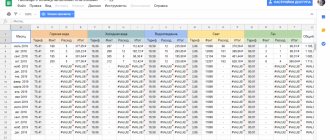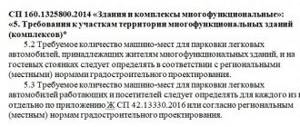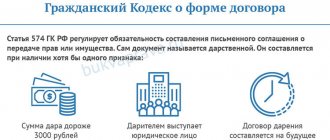Arrangement of communications during the construction or modernization of a house is a rather complex and responsible process.
Already at the design stage of these two important engineering systems, it is necessary to know and strictly follow the rules of water supply and sanitation in order to avoid future operational problems and conflicts with environmental services.
In our material we will try to understand these rules, which are difficult at first glance, and will tell our readers why a water meter is needed and how to correctly calculate the volume of water consumption.
Scope of influence of the regulatory document
“Rules for cold water supply and sanitation” is the full name of the document approved on July 29, 2013 under N 644. Last edition – April 2021, changes and additions are valid from April 12, 2018.
The rules define the relationship between subscribers (consumers of services) and organizations that supply them, based on the conclusion of binding contracts.
Concluding an agreement for the supply of water and sewerage will not take much time if you collect a full package of necessary papers in advance
The document also discusses:
- consumers of services - individuals, budget organizations, enterprises, etc.;
- algorithm for connecting objects to central systems (central systems);
- accounting of released water, accounting of diverted wastewater, quality control;
- consumers who are required to take into account the discharge of wastewater into the central heating system using measuring instruments;
- calculation of compensation for the discharge of excessively polluted wastewater, the procedure for informing about changes in their composition and properties (submission of declarations);
- standards, a mechanism for monitoring their use in practice, determining the amount of excess payment;
It must be thought out and provided, and if necessary, access to the subscriber’s water supply and sewerage communications, to the points of water and wastewater sampling must be created.
Image gallery
Photo from
Water supply and wastewater systems
Ensuring adequate water supply
Relationship between water supply and sewerage
Installation of an industrial drainage system
Rules for compiling a water balance
Calculation of the ratio of water consumption and wastewater volumes is carried out for each object individually with an assessment of its specifics.
The purpose of the building or premises, the number of future users, and the minimum (maximum) expected water consumption for domestic or industrial needs are taken into account. All water is taken into account - drinking water, technical water, its reuse, waste water, storm discharge into sewers.
Declaration of the composition and properties of wastewater - it is submitted to certain categories of subscribers
Goals and objectives solved by drawing up a balance sheet:
- Obtaining permission for water consumption and wastewater disposal when connecting to a centralized system;
- Selection of water and sewer pipes of optimal diameter;
- Calculation of other parameters - for example, the power of a submersible pump, if we are talking about using a well in a private household;
- Obtaining a license for the right to use natural resources (relevant again for the example described above - your own independent source of water);
- Concluding second-order contracts - let’s say you rent space in an office center, the owner of the building is the subscriber of the city water utility, and all tenants receive water from his (the owner’s) water supply and discharge wastewater into his sewer system. Therefore, the owner of the building must pay.
The water balance is a table that shows the ratio of water used and waste water discharged for the year.
There is no single form of such a table approved at the federal level, but the initiative is not prohibited, and water utilities offer their own filling out samples for customers.
You can draw up a balance of water consumption and sanitation yourself in MS Excel or use the help of sewerage and water supply design specialists
In general terms, drawing up a water balance for a small enterprise will look like this:
- Step 1. We enter consumer groups with numbering, name and quantitative characteristics in the first three columns.
- Step 2. We are looking for standards for each group for water consumption, using internal technical regulations (for the operation of bathrooms and showers), certificates (from the HR department about the number of personnel, from the canteen about the number of dishes, from the laundry about the volume of laundry), SNiP 2.04.01- 85 – “Internal water supply and sewerage of buildings.”
- Step 3. We calculate the total water consumption (cubic meters/day), determine the sources of water supply.
- Step 4. We enter data on water disposal, noting separately irrecoverable losses (watering lawns, water in the pool, etc. that does not go into the sewer).
As a result, the reasonable difference between water disposal and water consumption can be 10-20%. As a rule, values up to 5% are neglected and it is considered that the discharge into the sewer is 100%.
In addition to timely payment for water supply and sanitation services, the subscriber assumes other obligations
Water consumption
LLC "***" for the needs of the enterprise extracts underground water from well No. *** (license No. *** No. *****) in the amount of 595 m3/day (148,129 m3/year) and receives it under an agreement from the OJSC “****” (contract No.) in the amount of 50 m3/day (12,450 m3/year).
Water intake well No. *** “T” is located in ****, which in hydrogeological terms is a system of small artesian basins filled with sandy-clayey Pliocene deposits and separated by anticlinal ridges composed of practically waterproof Miocene rocks.
Below is a brief hydrogeological description of the aquifer complexes of this basin.
The aquifer of Quaternary sediments (Q) lies to a depth of 17-25 m. The horizon is composed of loams and clays with rare interlayers and lenses of fine-grained sands, often clayey. The water abundance of the horizon is characterized by well flow rates of 0.5-2.0 m3/hour with a level drop of 0.1-1.5 m. In terms of the chemical composition of the water, calcium sulfate water does not comply with SanPiN 2.1.4..1074-01 “Drinking Water”, in terms of dry residue - up to 3 g/l and in terms of total hardness - up to 12 mEq/l. .
The aquifer of undifferentiated deposits of the Upper Pliocene lies in the depth range from 17-20 to 140-145 m. The water abundance of the complex is characterized by well flow rates of 10-18 m3/hour with a drop in water level of 12-20 m. The filtration coefficient is 3.5 m/day , water conductivity 120 m3/day, piezoelectric conductivity - 5x 10 m/day.
Piezometric levels are currently installed at a depth of 12-15 m from the earth's surface. The hydraulic slope is 0.0008 when the groundwater flow is directed westward.
The chemical composition of the water is hydrocarbonate-chloride-sulfate, calcium-sodium. The dry residue is 1.7-3.2 g/dm3, the total water hardness of the horizon is 8-22 mmol/dm3.
The aquifers of the Upper Pliocene complex are fed by the flow of water from the overlying aquifers.
The aquifer of Cimmerian deposits lies in the depth range from 140-145 m to 210-220 m and is represented by 2-3 aquifers. The thickness of individual sand layers ranges from 9 to 15 m, their total thickness reaches 30 m.
The water abundance of the complex is characterized by well flow rates of 15-30 m3/hour with a drop in water level of 20-33 m. The filtration coefficient is 5 m/day, water conductivity is 150 m2/day, and piezoelectric conductivity is 5 x 105 m2/day. Pizometric levels are set at levels from 1.5 m below the earth's surface to +2.0 m above it, the hydraulic slope is 0.002 when the groundwater flow is in the western direction.
The chemical composition of the water is sodium chloride with mineralization up to 1 g/dm3 and a total hardness of 2.5-3.9 mmol/dm3. An increased content of hydrogen sulfide is noted.
The waters of the Cimmerian horizon are widely used throughout the area for economic purposes.
The first belt of the sanitary protection zone is allocated (12m in the western direction, 9m in the northern direction, 16m in the eastern direction, 21m in the southern direction), the site is landscaped and landscaped, fenced with a mesh fence with lockable metal gates. There are paved paths. On the territory of the 1st belt zone, weeds and undergrowth are regularly cut down. A concrete blind area was made around the wellhead with a width of 1.5 m and a depth of 0.7 m to prevent the possibility of production horizons. At the entrance to the water intake area there are signs “Strict security sanitary protection zone” and “Unauthorized entry is strictly prohibited”
The territory of LLC “***” falls within the sanitary protection zone of the second zone of the water well. The sanitary protection zone of the second zone has the form of a circle around a well with a radius of 60 m and is confined to an area where there are no sources of microbiological pollution, and the exploited aquifers are classified as protected. The existing production buildings of LLC "***" are sewered, the territory of the enterprise is asphalted.
The sanitary protection zone of the third belt is an ellipse around the well (upstream in the northwest direction 728 m, downstream 364 m, perpendicular to the flow in both directions 593 m). The third zone zone includes both the territory of LLC “***” itself and private households of Art. ***, adjacent areas free of buildings and agricultural land. There are no obvious sources of chemical pollution of groundwater within the third level of sanitary protection. The territories are paved, the premises are sewered, a network of rain sewers and storm drains is provided, etc. Agricultural lands falling within the third belt of the sanitary protection zone are used without introducing highly toxic fertilizers into the soil. Wastewater is discharged into the in-plant sewerage system and then released into a storage pond at a distance of about 5 km from the wellhead. Vehicle parking areas and railway tracks falling within the third belt zone cannot be a source of groundwater pollution, since the exploited aquifers are classified as protected, and the necessary set of special measures have been carried out on the territory of parking lots aimed at preventing groundwater pollution: the areas are paved with asphalt, network of storm sewers and storm drains, etc.
Requirements for installing water meters
An accurately calculated water balance is a significant argument in justifying charges for water use. With it, you can try to challenge the supplier’s inflated average tariffs, which include the cost of water losses as a result of pipeline accidents, repair work, leaks in basements, prove the need to take into account the seasonality factor, etc.
Practice shows, however, that the truth is not easy to achieve, and the best way out is to install a water supply meter. According to his readings, the amount of water used is determined down to the drop.
If you have a meter, the calculation for water is simplified: the indicator taken from the display is multiplied by the price of 1 cubic meter of water. Thus, counting devices are mounted on both cold and hot water pipes. It is important to monitor the safety of the seals and periodically (once every few years) check their serviceability.
For sewer systems, waste water meters are not provided (with the exception of specific industrial enterprises). Their volume is equal to the volume of water consumed.
Common house and individual water meters help save housing and utility costs. The amount of money in the receipt directly depends on the number of cubic meters saved. The massive introduction of water meters into life also disciplines the employees of water utilities. It is no longer possible to uncontrollably attribute losses from water losses due to worn-out water supply and sewerage networks to the consumer.
The water supply rules are supplemented with provisions regarding the installation of meters and their commissioning. You can install the device yourself and invite a specialist to your home to seal it.
There are two requirements for installing a water meter:
- Place a coarse filter in front of the device to protect against small debris found in tap water.
- Use a check valve at the outlet of the meter to prevent it from spinning in the opposite direction.
Before purchasing a meter, you must check its passport data and compare it with the numbers on the body and parts of the device. You should also inquire about the verifications carried out and make sure that the installation kit is available.
Check the functionality of the purchased device before purchasing it and before connecting it to the mains
How is the payment calculated?
Utility bills, as a rule, are calculated either based on the readings of individual meters installed directly in the residential premises, or based on consumption standards and the number of people registered in the apartment (private house, cottage).
In apartment buildings, communal meters must be installed that record the volume of water used. In fact, in Russia such devices are rarely installed. Therefore, the wastewater of a house is considered as the arithmetic sum of the residents’ consumption of all water: hot and cold.
The cost of the service is calculated by multiplying the sewerage standard for one person without a meter by the approved tariff. Standards are set by local authorities. Tariffs are reviewed annually, usually in the middle of the calendar year, approved and posted in the media and on the websites of management companies.
Residents of the house can initiate the installation of a common building meter to account for wastewater. To do this, you need to write an application to the management company and obtain permission. Payment calculations after installation of the device will be carried out differently, but this does not guarantee a reduction in the cost of the service.
Examples of calculating water consumption and wastewater disposal
The load on pipelines and devices that ensure an uninterrupted supply of water to various sanitary equipment (kitchen sink, bathroom faucet, toilet, etc.) depends on its consumption rates.
When calculating water consumption, the maximum water consumption per day, hour and second is determined (both total and cold and hot separately). There is a calculation method for water drainage.
Based on the results obtained, the parameters of the water supply system are established according to SNiP 2.04.01-85 - “Internal water supply and sewerage of buildings” [1] and some additional ones (meter passage diameter, etc.).
Example 1: calculating volume using formulas
Initial data:
A private cottage with a gas water heater, 4 people live in it. Plumbing fixtures:
- faucet in the bathroom – 1;
- toilet with flush cistern in the bathroom – 1;
- faucet in the kitchen sink - 1.
It is necessary to calculate the water flow and select the cross-section of the supply pipes in the bathroom, toilet, kitchen, as well as the minimum diameter of the inlet pipe - the one that connects the house to a centralized system or source of water supply. Other parameters from the mentioned building codes and rules are not relevant for a private house.
The methodology for calculating water consumption is based on formulas and regulatory reference material. The detailed calculation methodology is given in SNiP 2.04.01-85
Calculation:
1. Water consumption (max) per 1 second. calculated by the formula:
Qsec = 5×q×k (l/sec) , where:
q – water flow per 1 second. for one device according to paragraph 3.2 [1]. For the bathroom, toilet and kitchen - 0.25 l/sec, 0.1 l/sec, 0.12 l/sec, respectively (Appendix 2 [1]).
k – coefficient from Appendix 4 [1]. Determined by the probability of action of plumbing ( P ) and their number ( n ).
2. Define P :
P = (m×q1)/(q×n×3600) , where
m – people, m = 4 people;
q1 – the total maximum rate of water consumption for the hour of greatest consumption, q1 = 10.5 l/hour (Appendix 3 [1], the presence of a water supply system, a bathroom, a gas water heater, a sewer system in the house);
q – water consumption for one device per 1 second;
n – number of plumbing units, n = 3.
Note: since the value of q is different, we replace q * n by summing the corresponding digits.
P = (4×10.5)/((0.25+0.1+0.12)×3600) = 0.0248
3. Knowing P and n , we determine k according to Table 2 of Appendix 4 [1]:
k = 0.226 – bathroom, toilet, kitchen (based on n × P, i.e. 1×0.0248 = 0.0248)
k = 0.310 – cottage as a whole (based on n × P, i.e. 3x0.0248 = 0.0744)
4. Let's determine Qsec :
bathroom Qsec = 5×0.25×0.226 = 0.283 l/sec
bathroom Qsec = 5×0.1×0.226 = 0.113 l/sec
kitchen Qsec = 5×0.12×0.226 = 0.136 l/sec
cottage as a whole Qsec = 5×(0.25+0.1+0.12)×0.310 = 0.535 l/sec
So, the water flow is obtained. Let us now calculate the cross-section (internal diameter) of the pipes using the formula:
D = √((4×Qsec)/(PI×V)) (m) , where:
V – water flow speed, m/sec. V = 2.5 m/s according to paragraph 7.6 [1];
Qsec – water consumption in 1 sec., m3/sec.
bathroom D = √((4×0.283/1000)/(3.14×2.5)) = 0.012 m or 12 mm
bathroom D = √((4×0.113/1000)/(3.14×2.5)) = 0.0076 m or 7.6 mm
kitchen D = √((4×0.136/1000)/(3.14×2.5)) = 0.0083 m or 8.3 mm
cottage as a whole D = √((4×0.535/1000)/(3.14×2.5)) = 0.0165 m or 16.5 mm
Thus, a pipe with an internal cross-section of at least 12 mm is required for a bathroom, 7.6 mm for a bathroom, and 8.3 mm for a kitchen sink. The minimum diameter of the inlet pipe for supplying 3 plumbing fixtures is 16.5 mm.
Example 2: simplified definition
Those who are intimidated by the abundance of formulas can make a simpler calculation.
It is believed that the average person consumes 200-250 liters of water per day. Then daily consumption for a family of 4 people will be 800-1000 liters, and monthly consumption will be 24,000-30,000 liters (24-30 cubic meters). In private houses in the courtyards there are swimming pools, outdoor showers, drip irrigation systems, i.e. part of the water consumption is irrevocably carried out onto the street.
Approximately a quarter of the total volume of water intended for household needs is flushed into the toilet
Water consumption is increasing, but there is still a suspicion that the approximate standard of 200-250 liters is unreasonably high. And indeed, after installing water meters, the same family, without changing their everyday habits, adds 12-15 cubic meters to the meter. m, and in economy mode it turns out even less - 8-10 cubic meters. m.
The principle of drainage in a city apartment is this: as much water as we consume, we pour into the sewer. Consequently, without a meter they will count up to 30 cubic meters. m, and with a meter - no more than 15 cubic meters. m. Since in the private sector not all consumed water goes back to the sewer system, it would be fair to use a reduction factor when calculating water disposal: 12-15 cubic meters × 0.9 = 10.8-13.5 cubic meters. m.
Both examples are conditional, but a table with a real calculation of water consumption and disposal, which can only be done by a qualified engineer, should be available to all economic entities (enterprises, housing stock) that collect water for drinking, sanitary and hygienic, industrial needs and discharge drains.
Responsibility for the reliability of the data used in the calculation rests with the water user.
The owner of an apartment in a multi-storey building uses water in the bathroom and toilet much more often than in the kitchen. For the owner of a country cottage, water use priorities depend on the full or partial availability of amenities
Estimated number of simultaneous fires
| Enterprise area, ha | Number of residents in the locality, thousand people. | Number of simultaneous fires |
| Less than 150 | To 10 | 1* |
| From 10 to 25 | 2** | |
| More than 150 | Less than 25 | 2* |
** One at the enterprise and one in the populated area* At the enterprise or in the populated area - according to the highest consumption.
In case of several industrial enterprises and one populated area, the estimated number of simultaneous fires is accepted in agreement with the State Fire Supervision authorities. The estimated cost for fire extinguishing should be provided at the highest cost for other needs.
The maximum recovery period for untouchable fire-fighting flow stored in tanks is 1-3 days. depending on the fire hazard category of the facility.
Determination of estimated water consumption. The regime of water consumption by the population for household and drinking needs is largely random and difficult to control. Therefore, to be able to obtain a sufficiently accurate and economical design solution for a water supply system, it is necessary to know the estimated schedules of water consumption by the population.
Water consumption for household and drinking needs is uneven both throughout the year and throughout the day. Flow changes are observed: seasonal, caused by changes in air temperature and humidity; weekly, due to the characteristics of people’s life activities on different days of the week, as well as daily allowances ,
The latter are characterized by uneven water consumption at certain times of the day, which largely depends on the degree of improvement and changes in pressure in the water supply network.
Changes in hourly expenses can also be caused by such random factors as the showing of popular television programs, sporting events, etc. The social and demographic composition of the population has a significant impact on the water consumption regime.
To obtain water consumption schedules, a series of observations of water consumption in settlements that are similar in population, climatic conditions, sanitary and technical improvement of residential areas and demographic composition is required.
A forecast of the water consumption regime is necessary to determine such quantities as water consumption, regulating volumes of water in containers, energy costs for transporting water, etc. It should serve as the basis for solving management problems: optimal distribution of loads between power sources, selection of operating units, etc. It should be noted that developing graphs that adequately reflect the water consumption of the object in question is very difficult and time-consuming.
In practice, this leads to the need to use approximate graphs, the degree of simplification of which depends on the characteristic features and requirements of design and operation.
Based on data on water consumption standards, information on the estimated number of residents and the water needs of industrial enterprises taking water from the city water supply, the total average estimated amount of water that should be supplied to the city during the day can be determined.
For household, drinking and household needs of the population, the average daily water consumption Q, m3/day, is determined as Q=qсрN
where qср is the annual average calculated water consumption per inhabitant, accepted in accordance with the current SNiP; N—estimated number of inhabitants.
Estimated volumes of water consumption by industrial facilities are determined on the basis of technological calculations.
The determined average daily water consumption can only serve as a general indicator of water demand. In fact, daily water consumption largely depends on the season of the year, climate change, and days of the week.
According to established canons, the water supply system must satisfy the population’s water needs on any day, including the day of greatest (maximum) water consumption.
The daily unevenness of water consumption is characterized by the coefficients of daily unevenness Kmaxday and Kminday. The maximum coefficient of daily unevenness is the ratio of the daily flow rate on the days of highest water consumption to the average daily flow rate for the year Q:
Kmaxday = Qmaxday / Q
The minimum coefficient of daily unevenness Kminday is the ratio of the daily flow on the days of lowest water consumption Qminday to the average daily flow for the year:
Kminday = Qminday / Q
These coefficients, taking into account the way of life of the population, the operating mode of enterprises, the degree of improvement of buildings, are taken equal: Kmaxday = 1.1-1.3; Kminday =0.7 -0.9. They were obtained as a result of an analysis of the unevenness of water consumption in existing water pipelines.
Maximum daily flow rate Qmaxday = Kmaxday * Q is the main flow rate for which the water supply system should be designed. However, it should be remembered that water consumption is also uneven throughout the day. The degree of uneven water consumption depends on the number of residents in the locality, as well as on the improvement of buildings, operating conditions of enterprises and other local conditions.
The water consumption regime during the day is determined based on the results of observations of existing water supply systems. They can be presented in tabular, integral, analytical or graphical form. The figure below shows an example of a stepped graph of water consumption, where the ordinate axis shows the values of hourly water consumption as a percentage of daily consumption.
Hourly unevenness of water consumption is characterized by maximum coefficients of hourly unevenness Kmaxhour and Kminhour, equal to:
Kmaxhour = Qmaxhour / Qavhour
Kminhour = Qminhour / Qaverhour
Maximum hourly flow rate for the day of greatest water consumption: Qmaxhour = Kmaxhour * Qmaxday /24
Rationing is the basic rule of any calculations
Each region has its own standards for water consumption (drinking, for sanitary and hygienic needs, for everyday life and household use). This is explained by different geographical locations and weather factors.
Let’s take the daily norms of volumetric parameters of water consumption and wastewater disposal, distributed for household and household needs. Let's not forget that they are the same in terms of water supply and disposal, but depend on how comfortable the home is.
Standard water consumption values:
- with an outdoor water stand - from 40 to 100 liters per person;
- apartment-type residential building without baths – 80/110;
- the same with bathtubs and gas heaters – 150/200;
- with centralized cold and hot water supply – 200-250.
There are also water consumption standards for caring for pets and poultry. They include costs for cleaning pens, cages and feeders, feeding, etc. 70-100 liters are provided for a cow, 60-70 liters for a horse, 25 liters for a pig, and only 1-2 liters for a chicken, turkey or goose.
Due to a small water leak, water supply costs will increase significantly. Some reserve for unexpected water consumption is a better fate when performing balance calculations
There are standards for the operation of vehicles: tractor equipment - 200-250 liters of water per day, car - 300-450. It is necessary to plan water consumption for fire extinguishing for all buildings and structures, regardless of operational purpose.
Even for gardening societies there is no exception: the water consumption rate for extinguishing a fire outside is 5 liters per second for 3 hours, for an internal fire - from 2 to 2.5.
Water for fire extinguishing is taken from the water supply. Fire hydrants are placed on water pipes in wells. If this is not technically feasible or unprofitable, then you will have to take care of a reservoir with a supply of water. This water must not be used for other purposes; the period for restoring the supply in the reservoir is three days.
Irrigation water consumption per day: 5-12 l/m2 for trees, shrubs and other plantings in open ground, 10-15 l/m2 – in greenhouses and greenhouses, 5-6 l/m2 – for lawn grass and flower beds. In industry, each industry has its own characteristics of rationing water consumption and waste disposal - pulp and paper production, metallurgy, petrochemicals, and the food industry are water-intensive.
The main purpose of rationing is to economically justify the norms of water consumption and drainage for the purpose of rational use of water resources.
During a day off (cleaning the apartment, washing, cooking, bathing in the shower and bath), the average daily water consumption can be exceeded by 2-3 times
Standards for water consumption for irrigation of the territory
| Purpose of water | Unit | Consumption rate, l/m2 |
| Mechanized washing of improved road surfaces and areas | 1 sink | 1,2-1,5 |
| Mechanized watering of improved road surfaces and areas | 1 watering | 0,3-0,4 |
| Manual watering (with a hose) of improved pavement and driveway surfaces | 1 watering | 0,4-0,5 |
| Watering urban green spaces | 1 watering | 3-4 |
| Watering lawns and flower beds | 1 watering | 4-6 |
In the absence of data on areas by type of improvement, the specific average daily water consumption for the irrigation season is assumed to be 50-90 l/day per inhabitant. When assigning irrigation norms, climatic conditions, the power of the water supply source, the degree of improvement of populated areas and other local conditions are taken into account. Depending on the climate, the number of waterings is 1-2 per day.
Water consumption for fire extinguishing is determined according to regulatory documents (SNiP 2.04.02-84*), compiled on the basis of processing statistical data on actual water consumption when extinguishing fires at various facilities. The rates of water consumption for fire extinguishing depend on the population and the nature of the development.
Relationship between water consumers and service provider
By entering into a contractual relationship with a water supply and sewerage organization, you become a consumer of water supply/sewage services.
Your rights as a user of the service provided:
- demand from the supplier the continuous provision of appropriate services (standard water pressure, its chemical composition safe for life and health);
- apply for the installation of water meters;
- demand recalculation and payment of penalties if the service is not provided in full (the act must be drawn up within 24 hours after submitting the application);
- terminate the contract unilaterally, but subject to 15 days notice and full payment for the services received;
The subscriber has the right to receive payment information (personal account status) free of charge.
No water or barely flowing? Call the dispatch service and request the arrival of a representative of the water utility to draw up a report
List of rights of the second party:
- stop (with a few days' prior notice) the supply of water and the collection of wastewater, in whole or in part, if the technical condition of the water supply networks and sewerage systems is unsatisfactory;
- require access to the client’s territory to take readings of water meters, check seals, and inspect water supply and sewer systems;
- carry out preventative maintenance according to schedule;
- turn off water to debtors;
- stop water supply without warning in case of accidents, natural disasters, or power outages.
Disputes and disagreements are resolved through negotiations or in court.
